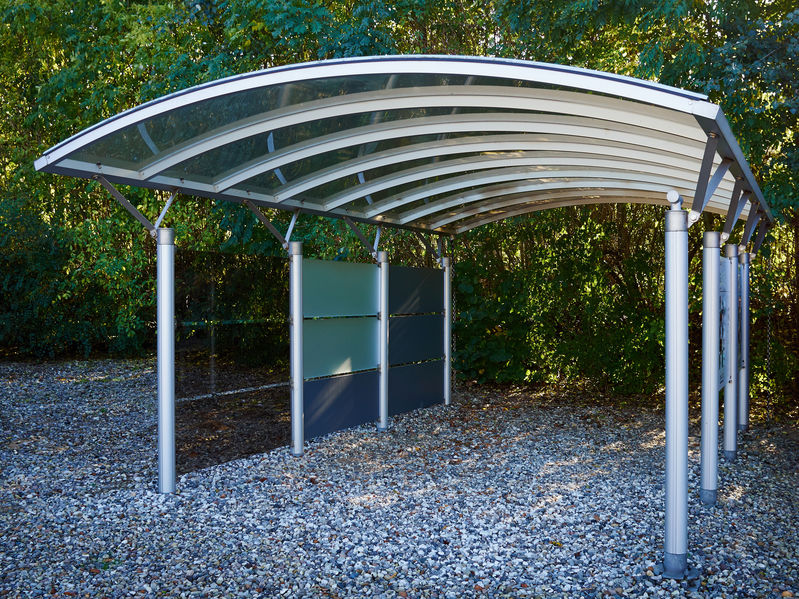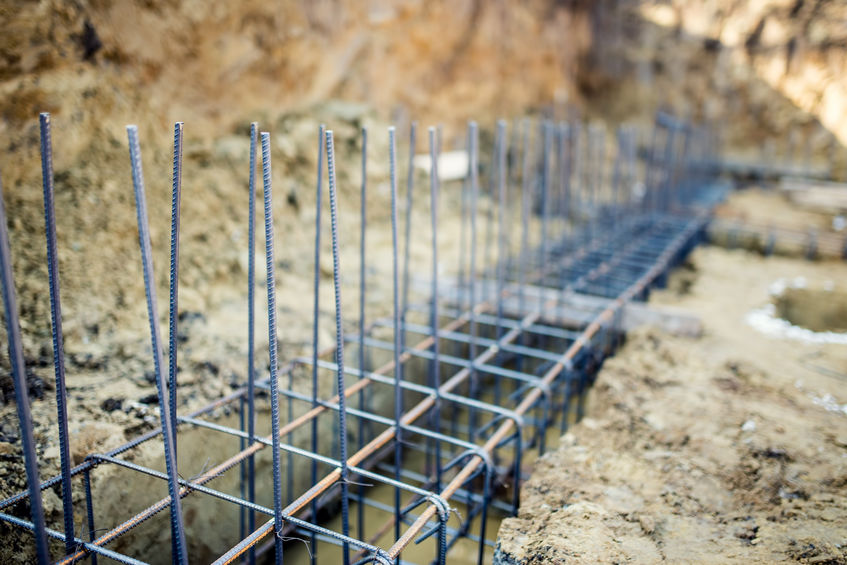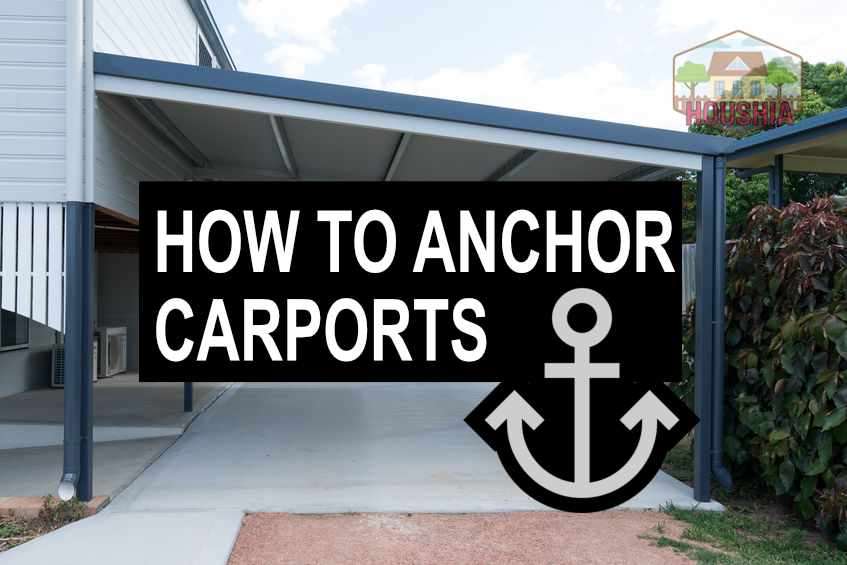In the following article, we’ll take a look at what anchoring a carport to the ground consists of, which tools you’ll need, some of the most common ways to anchor and what to consider when determining footer depth.
It is extremely important to make sure that as part of your set up, you anchor your carport to the ground securely enough so that it can resist strong winds, snowdrifts, heavy rains, etc.
After all, no one wants to wake up in the morning to find their carport blown away or collapsed on top of their vehicle!
What tools and materials will you need?

Depending on the surface type you’ll be anchoring the carport to, you will need different tools and other materials to get the job done.
While each job is slightly different and may require some extra supplies, here is a list of the basic tools for the more common installation methods.
- Anchors: These can be cement anchors, asphalt anchors, auger anchors, or even weight/ballast if your installation is meant to be impermanent. Make sure to consult the section on footing depth below so that you purchase the right length anchors.
- Cement expansion: For installation on cement, you’ll want to have some expansion material to ensure a tight fit around your anchors.
- Asphalt grout or other bonding material: For asphalt installations, you’ll want to have grout or some other type of bonding material to ensure there are no gaps or cracks around your anchor holes.
- Masonry drill bits: If you’re anchoring your carport to cement or asphalt, you definitely want to make sure to have the right size and type bits for drilling into the surface material you’re anchoring to.
Be sure to consult with your local hardware store if you’re unsure what type to purchase for the job.
- Electric screwdriver: Make sure you have a powerful enough screwdriver to drive the masonry bits mentioned previously.
- Sledgehammer: If you’re installing your carport on gravel, you will definitely need a sledgehammer to drive it in. This can also be a handy tool when installing on dirt, as you can use it to tap the anchors in place before driving them home with rotation.
- Post digger or narrow shovel: If you are going to be anchoring to dirt or soil, you’ll want a tool to help you dig out the pilot holes for your anchors. A post digger works best, but a narrow shovel or even a spade can work as well.
- Metal rod or sturdy tool handle: You’ll need this if you are using screw-type anchors, such as when installing in dirt. By passing the rod or handle through the anchors’ eye holes, you can use leverage to drive them in without too much of a hassle.
How do you secure a carport to the ground?

You can secure your carport to the ground in a number of different ways. For permanent installation, you can install the carport atop a concrete slab and anchor it to the same.
Alternatively, you can stabilize the carport in gravel or dirt using different types of anchors.
For a portable carport that you may wish to disassemble or move at some point in the future, you can use anchors or, alternatively, water ballasts or other weights to keep the structure in place.
Let’s have a look at the step-by-step process for each installation type.
How to anchor a carport to concrete
- When installing your carport on a concrete slab, the first thing you’ll want to do is to ensure the surface is flat and level.
- If your concrete slab is recently poured, you want to ensure it has had sufficient time to dry completely before drilling into it.
- Consult the manufacturer’s documentation included with your carport model to determine the best location for installing the anchoring points.
- Now you’ll want to drill holes for your concrete anchors in both the cement and the base rails of your carport, making sure they line up. Use a masonry bit and sufficiently high-powered drill. Alternatively, you could hire a handyperson or contractor to do the drilling for you.
- Making sure you have the correct length anchors for your installation, put some concrete expansion material in the holes you’ve drilled, and start tightening down the nuts with locking washers. It is best to get all your anchor points finger tight and make sure your structure is lined up right before you proceed to your final tightening of the bolts.
- Attach the carport base or poles to the installed cement anchors.
How to anchor a carport to gravel
- The first step when installing a carport on gravel or crushed stone is to inspect the surface and ensure it is both level and free of any foreign materials, such as larger rocks or branches, etc. You can use a rake to even out any uneven gravel.
- Next, you want to locate the anchor holes in the base rails of your carport structure. Drill each of these holes out if they are not already drilled.
- Depending on how hard the earth underneath the gravel is, you may need to use a post digger or some other tool capable of boring a hole big enough to receive the anchors you’ll be using. Typically, you’ll want to use a rebar anchor of at least 30 inches in length.
- Thread each anchor through the corresponding hole in the carport’s base rails and push it into the ground beneath. You’ll want either to prop the anchors up or have an extra pair of hands to help hold them steady.
- Drive the anchor into the earth with a sledgehammer, careful to strike straight down against the anchor head.
- Continue working each anchor into the ground until the anchor is flush against the base rails.
- Attach the carport base or poles to the installed anchors.
How to anchor a carport to dirt
Note that the process for anchoring a carport to dirt or soil is similar to the process for installing one on gravel or crushed stone.
- Get started by inspecting the installation site, making sure it is level and clear of any obstructions. It is a good idea to measure and mark the dimensions of the space you’ll need to accommodate the carport and to leave some extra room around it, as well.
- Locate the anchor holes in the base rails of your carport structure and drill them out if they are not pre-drilled. You’ll also want to make some pilot holes in the earth directly beneath the anchor holes in the base rails.
- The most recommended type of anchor for installing a carport in dirt or soil is an auger anchor, also sometimes referred to as a mobile home anchor. These anchors have a wide thread that essentially lets you screw them into the earth. These are typically 32 inches long.
- Thread each anchor through the corresponding hole in the carport’s base rails and push it into the ground beneath.
- Now you’ll want to drive the anchors into the ground by passing a metal rod, the handle of a sturdy tool, etc. through the anchor’s eye hole and turning in a clockwise fashion.
- Continue twisting each anchor into the ground until the anchor is flush against the base rails.
- Attach the carport base or poles to the installed anchors.
How to anchor a carport to asphalt
You can definitely install your carport on asphalt. However, because asphalt is composed of tiny bits of aggregate materials, it can easily fracture under direct pressure.
For this reason, rather than using expansion bolts, as when installing on cement, it is best to use special asphalt anchors.
These anchors are designed with barbs along the shaft which will hold them in place without fracturing your asphalt surface.
- Make sure your asphalt surface is level and smooth, and free from any obstructions or debris.
- Locate the holes you’ll be using along your carport’s base rails and drill them out if they’re not already pre-drilled.
- Using a masonry bit, drill out your anchor holes in the asphalt, lining them up with the base rails holes. You don’t want to apply too much pressure; rather, let the drill do the work for you.
- Put some grout or other bonding material in the holes, but only if you are installing the anchors right away, as these materials dry rapidly.
- Thread the asphalt anchors through the holes in the base rails and into the underlying holes you previously drilled.
- Ensure that your anchors remain vertical, propping them in place if necessary, as the bonding material dries.
- Attach the carport base or poles to the asphalt anchor.
We have an entire article dedicated to anchoring carports to asphalt. So if you are interested in how to anchor to asphalt then you should definitely check it out.
How to anchor a portable carport
Depending on how long you want to leave your carport installed in place, as well as the weather conditions you expect it will be subject to, there are a number of options for less permanent anchoring.
- Concrete precast blocks: Another option you might consider is to use concrete blocks to anchor your carport. Just be aware that they can weigh anywhere between 500 to several thousand pounds, so moving them around is not an easy task.
- Water barrels: This is a somewhat old-fashioned method for securing above-ground structures, but in a pinch, it can get the job done. A single water-filled barrel can offer up to 500 pounds of resistance, so even just a couple of barrels can offer you fair anchorage.
The downside of this option is that water barrels have a high center of gravity versus ground-installed anchor points and can thus slide around in heavy weather.
- Sandbags: Sandbags are another simple and affordable option you can use to weight and stabilize your carport. That said, they are not recommended for long-term use nor for strong winds.
How deep should footings be for a carport?

There are no standard footing sizes or depths. Therefore, depending on your carport model and size, the anchoring system you are using, and the surface type you will be installing your carport on, recommended footing depths can vary.
Typically, footings range between two to four feet, but here are some of the factors to consider when determining the footing depths for your carport installation.
- Width and length: The bigger your carport’s area, the larger footings you’ll need to stabilize it, and by extension, the deeper you’ll want the footings to be.
- Height: Similar to width and length, the taller your carport is, the larger and deeper your footings will need to be to provide it with the proper support.
- Wind strength: You should obviously take local weather into consideration when determining footer depth. Stronger and more frequent winds should correspond to larger and deeper footings.
- Post size: Lastly, the bigger your carport posts, the larger and deeper you want your footings to be in order to accommodate them.
Do your homework before deciding on a carport and anchoring system
As you can see, there is a wide variety of carport styles and a range of options in terms of how to anchor them to the ground.
Therefore, before you take the plunge and purchase a carport, you’ll want to consider a number of factors and do your homework accordingly.
Be sure to think about the carport size you’re going to need and the location available to you for its installation. Based on the site you’ve chosen, you want to check what type of surface type it is.
If it’s unpaved, you may wish to – or need to – lay a cement foundation or gravel above it.
Lastly, be sure to pick the right anchor type for your surface type, as there are many types and sizes available on the market.
If you’re enjoying this article then why not check out these related articles after finishing this one:
Is it Cheaper to Build a Carport or Buy One? (Easy Checklist)
Which Garage Door Opener Is The Quietest?
What Does a Smart Garage Door Opener Do?! Let’s find out

